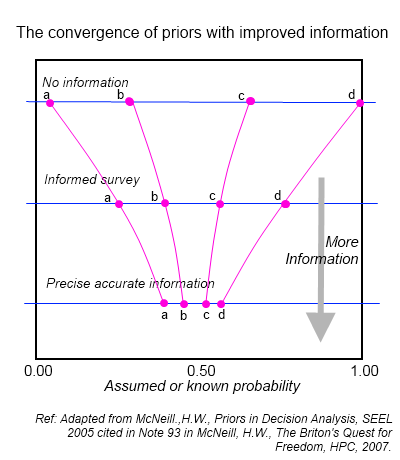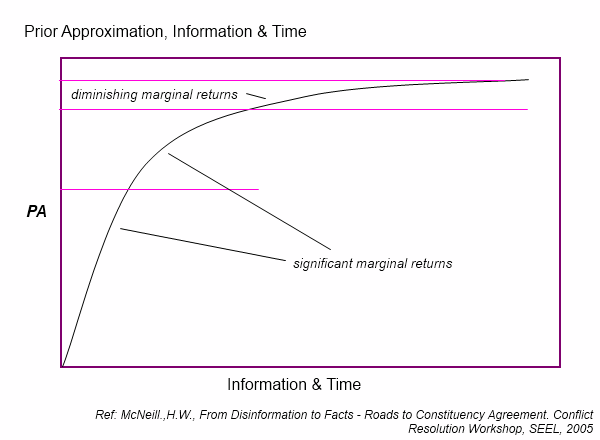Professional colleagues naturally share a common interest related to their work but they are usually quite distinct in their other interests, some of which can be more important to them than professional activities...
Productive relationships are fundamental to contentment and family life and these shape individual conscience. We each contribute elements to the community conscience that finds commonality in shaping values and what are considered to be normal social expectations of behaviour and treatment.
An aging population is creating a growing minority requiring more resources. Clearly supporting this minority is in the interests of all.
Within each profession, productive relationships at work see an experienced minority passing on advice to a younger minority resulting in the productivity of work increasing and contributing to a growth in the real incomes of the majority. |
|
|
The Minority Principle
The Minority Principle1 was proposed by Hector McNeill in 2007 as a constitutional provision to prevent so-called Majority rule (the Majority Principle) degenerating into factional rule whereby an influential minority or faction gains power to impose their dogma on the majority. The Minority Principle is a more transparent basis for decision-making and is not restricted to the common notions of minorities such as ethnic or religious groups. The Minority Principle is designed to ensure that the views of the social constituency as well as all members of the economic constituency have their concerns taken into account in legislative and policy decision-making. In the case of economic policy, for example, the Minority Principle reduces the likelihood that macroeconomic policy will generate winners, losers and policy neutral impact states.
Building Agreement for Better Decisions
Chapter 23 in "The Briton's Quest for Freedom .. Our unfinished journey…" sets out the basic articles of the Minority Principle . This is designed as a constitutional amendment to promote the full consideration of the preferences of all affected by a decision with the objective of ensuring that any final decision does not impinge of the freedom of expression of any member of a group. The Minority Principle in its entirety also removes the almost 50 specific constraints on individual freedom that exist as a result of administrative and political manipulation of the existing elements of the British Constitution.
Why replace the Majority Principle?
A common retort to the whole concept of a Minority Principle, especially on the part of politicians, is that it is impossible to get everyone to agree on a decision and this is why things should be decided by majority vote. Unfortunately, as we know, the "majority principle" put in power a government (1997) on the basis of their having gained about 20% of the electorate support and this government took us to two wars against the wishes of 80% of the electorate. One might say that anything that can avoid that sort of abuse is better than what we have now.
Clearly where there exist identifiable minority groups or a specific decision requires consideration where there may be people who might disagree it is important to distinguish why there is disagreement.
What is a decision?
For this discussion we define a decision as an irrevocable allocation and use of resources to actions designed to implement the processes required to achieve a specific objective. The fact that resources will be spent as a result of a decision make decisions important.
Priors
Everyone, as a result of background, upbringing, nature, education and experience have differing interests and understandings of the operational details of any process. Depending upon the levels of accurate knowledge people have on different topics they will have different personal estimates of the likelihood of the degree to which cause and effect relationships will result in a specific outcome. An individual's estimate of the likelihood of any event is known as a prior. Therefore people agree on the likely outcome of a decision because they all understand cause and effect relationships surrounding the outcome and the process required to establish that outcome (deterministic model) then they are likely to agree, if the specific outcome identified is what they want. However, when the deterministic model is less well defined or the relationships not clear there is a need to collect more information so as to understand better the likely outcome of a decision as well as perhaps identify better options for securing desirable outcomes. The objective of the exercise is to bring people's priors closer together so as to extend the degree of agreement across a population of decision-makers.
Besides the information on cause and effect relationships, that is, what determinants or factors will influence events so as to achieve an outcome there still remains a need to agree on the likelihood of such determinants or factors being present or available so as to achieve the final objective. This involves a need to agree on the probability of events occurring and determinants being as expected in order to achieve the outcome desired. Again this is a question of sufficient high quality information being made available to bring priors closer together.
The diagram below shows a "Decision-Maker Constituency Function" which equates 360o with a range of constituency participation in decision-making from 0% to 100%. Starting at point A we have an imaginary situation where there is one decision-maker and the constituency is simply not involved (generally classified as autonomous decision-maker). As we move clockwise the percentage of the constituency included in the decision-making process increases (the blue zone) rising from 1% to around 37% in the B zone. This is by no means full participation but can be classified as factional decision-making where a reduced number of people make the decisions. From then on the percentage of the constituency involved in decision-making increases up to 100% participation. Once we move above 60% participation the process can be loosely defined as participatory (Zone C).

The main issue is that as we move up through the levels of participation the complex of different types of people that are included in the process increases and therefore the dispersion of priors on any particular question will tend to diverge.
Assertion & majority voting
Because within the political processes politicians have an agenda they wish to sell, there tends to be a bias in the way the case is argued. Indeed, often there is no analysis but rather an assertion that one thing is better than another. This immediately creates disagreement and the result of such tussles is a vote where the "majority" win leaving a disgruntled "minority". The problem is that the combative exchanges where partisan interests are bent on conquest, winning the argument based on a vote, there is very little investment in the provision of a balanced decision analysis where all of the facts are laid out. As a result no attention is paid to trying to merge priors or even looking for better options.
Knowledge, Information, Data & Communications
Communications techniques and technologies have a vital role in collecting data to provide information of specific issues and appropriate analysis can build up a knowledge base of state of the art (what is currently achievable) as well as what might be achievable with associated levels of probability. Therefore the vital component in reducing disagreements that prevent effective participatory decision-making is logical data acquisition, analysis and the communication of knowledge in an appropriately transparent and rigorous manner.
The diagram below illustrates a transition in individual priors as the levels of knowledge is increased. The basic tendency is for the priors to converge and therefore for there to be increased agreement on the facts.

Gathering information can be time consuming and expensive so there tends to be a trade off between gathering sufficient information so as to help clarify the pertinent facts surrounding a decision so that priors can be brought close enough to achieve unanimous decisions.
Normally the returns to investment in information gathering and gaining of knowledge on inter-relations is high at the beginning of a process with an immediate impact on prior approximation. However, there is a point beyond which the marginal gain in prior approximation to further investment in information gathering and analysis is too low to justify the expense.
The diagram below illustrates this general relationship.

The success of the Minority Principle depends upon the collection, analysis and communication of relevant information to any particular decision so that there is agreement on the facts and probabilities surrounding any particular decision, the likely costs and likely outcomes. Without this investment in adequate information collection, analysis and its timely and appropriate communication to decision-makers, no matter how many, decision-making will tend to be factional, disruptive and outcomes will impinge of the freedom of others.
The Minority Principle is all-inclusive and in terms of communities it represents an approach to community decision-making that reduces conflict. The challenge is to organize state of the art information and communications technologies to serve the specific purpose of delivering relevant high quality information wherever it is needed in support of this process.
1 McNeill, H.W., Chapter 23, "The Minority Principle" pages 247-264, in The Briton's Quest for Freedom Our unfinished journey ... 418pp, HPC, 2007.
|
|
|
|
|